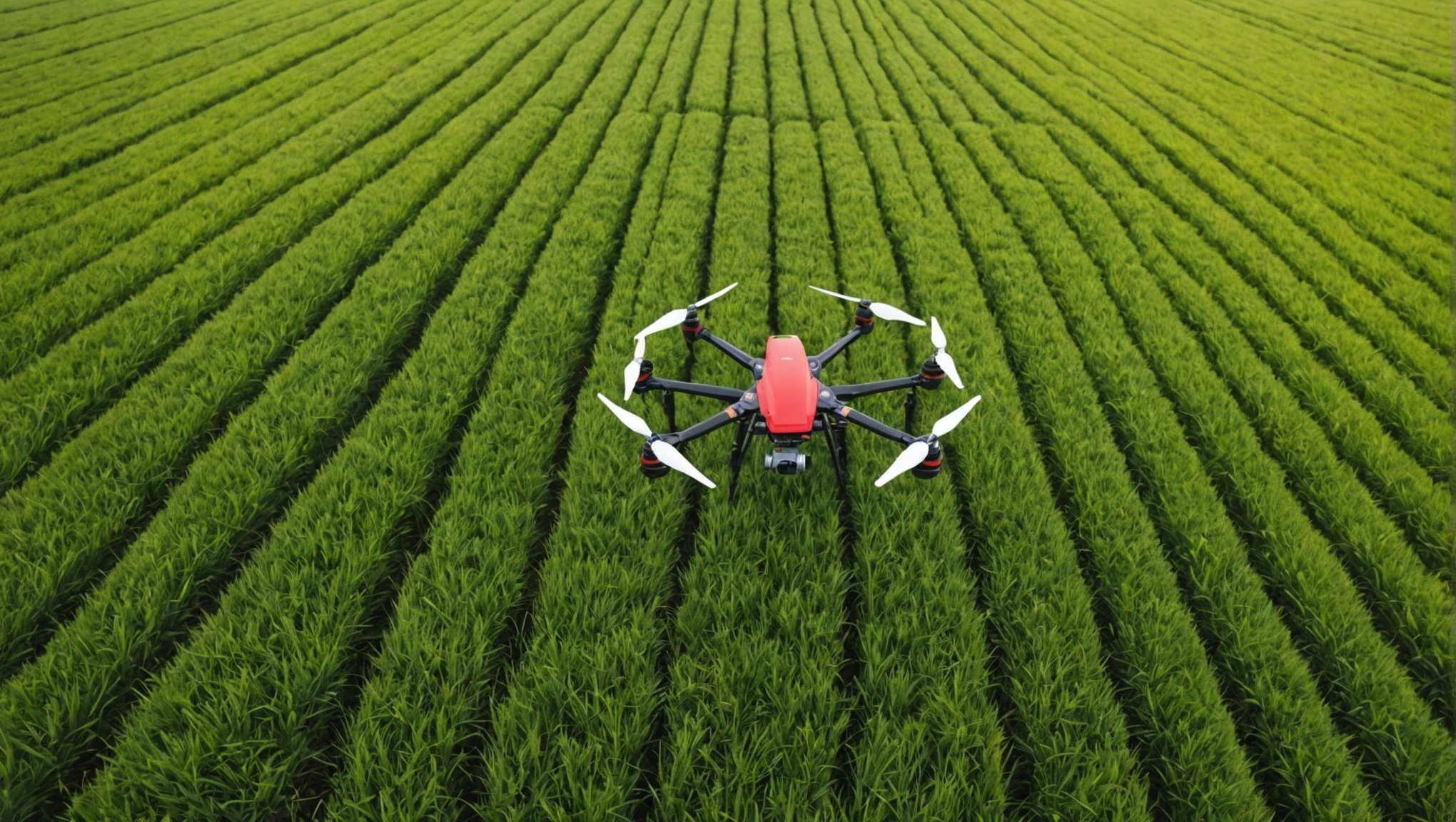Precision farming is transforming UK agriculture, and drones are at the forefront of this revolution. These innovative tools enhance efficiency, monitor crop health, and optimize resource use, ultimately driving better yields. This exploration of drone applications reveals how agricultural enterprises can harness cutting-edge technology to address challenges and improve sustainability. Discover the practical benefits of adopting drone solutions and learn how they can revolutionize your farming practices.
Overview of Precision Farming and Drone Technology
Precision farming represents a revolutionary approach to agriculture, focusing on enhancing productivity and efficiency. By utilising advanced technologies, farmers can manage variations in the field accurately. This method not only optimises resource use but also minimises environmental impact. Precision farming is crucial for addressing global food security challenges and promoting sustainable practices.
This might interest you : Leveraging Behavioral Finance: A Strategic Guide for UK Financial Advisors to Enhance Client Investment Choices
Drone technology plays a pivotal role in modern agriculture, offering farmers a bird's-eye view of their fields. These drones are equipped with sensors and cameras that capture high-resolution images. They provide critical data on crop health, soil conditions, and pest infestations. This information allows farmers to make informed decisions, ensuring timely interventions and efficient resource allocation.
In the UK, the agricultural landscape is rapidly evolving with the integration of these innovations. Farmers are increasingly adopting precision farming techniques to improve yield and reduce waste. The deployment of drone technology is becoming commonplace, aiding in tasks such as crop monitoring, irrigation management, and even livestock tracking. This shift not only enhances productivity but also aligns with the UK's commitment to sustainable agriculture. The synergy between precision farming and drone technology is set to redefine agricultural practices, making them more efficient and environmentally friendly.
In parallel : Unlocking Profits: A Data-Driven Approach to Menu Pricing Strategies for UK Restaurants
Benefits of Drones in Precision Farming
Incorporating drones into precision farming offers numerous advantages that significantly enhance agricultural efficiency. One of the primary benefits is cost savings through more efficient resource management. Drones provide precise data that allows farmers to apply water, fertilisers, and pesticides only where necessary, reducing waste and lowering expenses.
Another critical advantage is the enhanced data collection capability of drones. Equipped with advanced sensors, drones capture detailed images and data on crop health, soil conditions, and pest infestations. This rich information enables farmers to make informed decisions, optimising their crop management strategies. By identifying issues early, farmers can take targeted actions to address problems, preventing potential yield loss.
Moreover, drones contribute to increased yield and improved crop quality. By facilitating targeted interventions, farmers can ensure that their crops receive the exact nutrients and care needed. This precision leads to healthier plants and better-quality produce. Additionally, drones can monitor crop growth and development over time, allowing for timely adjustments in farming practices.
Overall, the integration of drones in precision farming not only boosts productivity but also aligns with sustainable agricultural practices. It empowers farmers to manage their fields with greater accuracy and efficiency, ultimately benefiting the agricultural sector.
Types of Drones Used in Agriculture
In the realm of agriculture, different drone types or UAVs (Unmanned Aerial Vehicles) are utilised to cater to various farming needs. Among these, multirotor drones are widely used for crop surveillance. They are known for their ability to hover in place, making them ideal for capturing detailed images of specific areas. This capability is particularly beneficial for monitoring crop health and spotting pest infestations.
Fixed-wing drones, on the other hand, are designed for large area mapping. Their aerodynamic structure allows them to cover extensive fields with ease. These agricultural drones are perfect for tasks that require long flight times and can efficiently gather data over vast areas, providing farmers with comprehensive insights into their land.
Lastly, there are hybrid drones that combine the features of both multirotor and fixed-wing drones. These versatile UAVs offer the hovering capabilities of multirotors and the long-range efficiency of fixed-wing drones. This combination makes them suitable for a wide range of agricultural applications, from detailed crop analysis to expansive field mapping.
By choosing the right type of drone, farmers can optimise their precision farming practices, ensuring efficient resource management and improved crop yield.
Innovative Drone Applications in UK Agriculture
In the realm of UK agriculture, the adoption of drone technology is transforming traditional farming methods. One of the standout drone applications is crop health monitoring through multispectral imaging. This cutting-edge technique allows farmers to assess plant health by capturing data beyond what the naked eye can see, such as chlorophyll levels and water content. This information is crucial for identifying stressed plants early, enabling timely interventions.
Another significant advancement is in precision spraying and fertilization. Drones equipped with precision technology can apply pesticides and fertilisers with remarkable accuracy, targeting specific areas rather than entire fields. This not only conserves resources but also reduces environmental impact by minimising chemical runoff.
Additionally, drones play a vital role in soil analysis and topographic mapping. By flying over fields, drones collect data that helps in creating detailed topographic maps. These maps are invaluable for understanding soil variation and planning irrigation systems. The insights gained from such analysis ensure that water and nutrients are distributed optimally, enhancing crop yield and quality.
Overall, the integration of these advanced drone applications in UK agriculture is paving the way for more efficient and sustainable farming practices.
Case Studies of Successful Drone Implementations
Exploring case studies of drone technology in agriculture reveals insightful examples of successful implementations. In the UK, several farms have harnessed this technology to enhance their operations. For instance, a farm in Norfolk integrated drones for precision spraying, achieving a 20% reduction in pesticide usage. This not only lowered costs but also minimised environmental impact.
Another compelling example is a dairy farm in Yorkshire that utilised drones for livestock monitoring. By employing aerial surveillance, the farm improved its herd management, leading to a 15% increase in milk production. The drones provided real-time data on livestock locations and health, allowing for timely interventions.
Lessons learned from these case studies highlight the importance of customising drone applications to specific farm needs. Successful implementations often involve collaboration between farmers and technology providers to tailor solutions. Key outcomes include improved resource efficiency, increased yields, and enhanced environmental sustainability.
These agriculture examples underscore the transformative potential of drones in farming. By examining these successful implementations, other farmers can gain valuable insights into integrating drone technology effectively, paving the way for more innovative and sustainable agricultural practices.
Regulatory Considerations for Drone Use in Agriculture
Navigating drone regulations is crucial for UK farmers integrating this technology into their operations. The UK Civil Aviation Authority (CAA) governs the use of drones, ensuring safety and compliance. Farmers must adhere to specific guidelines to legally operate drones in agricultural settings.
To begin, drone operators need to secure the necessary certifications. The UK farming laws require operators to obtain a Flyer ID and an Operator ID for drones weighing between 250g and 20kg. Additionally, for commercial use, such as in agriculture, the CAA mandates a General Visual Line of Sight Certificate (GVC). This certification ensures that operators are trained in safe drone handling and understand the regulations.
Compliance with drone regulations also involves following best practices to ensure safety and efficiency. Operators should maintain a safe distance from people and property, typically at least 50 meters away, and avoid flying over congested areas. Regular equipment checks and maintenance are essential to prevent malfunctions.
By understanding and adhering to UK farming laws, farmers can effectively use drones to enhance their agricultural practices while ensuring safety and compliance. This approach not only protects the operator but also promotes sustainable and responsible drone use in agriculture.
Future Trends in Drone Technology for Agriculture
As the agricultural sector continues to evolve, future trends in drone technology promise to revolutionise farming practices further. Emerging technologies are set to enhance drone capabilities, making them indispensable tools for farmers.
One significant trend is the integration of artificial intelligence (AI) and machine learning into drone systems. These advancements will enable drones to analyse data more effectively, providing farmers with precise insights into crop health and soil conditions. AI-powered drones can autonomously identify issues such as pest infestations or nutrient deficiencies, allowing for timely interventions.
Predictions for the evolution of drone applications in farming also point towards increased automation. Drones equipped with advanced sensors and AI will perform tasks such as planting, watering, and harvesting with minimal human intervention. This automation will lead to increased efficiency and productivity in agricultural operations.
Moreover, the potential impact of AI and machine learning on precision agriculture cannot be overstated. These technologies will enable drones to learn from past data, continuously improving their performance and decision-making capabilities. As a result, farmers will benefit from more accurate and efficient resource management, ultimately leading to higher yields and better crop quality.
Integrating Drones with Other Precision Farming Technologies
In the evolving landscape of precision farming technologies, the integration of drones with other advanced tools offers significant advantages. A notable synergy exists between drones and satellite imagery. While drones provide detailed, close-range data, satellites offer broader, large-scale observations. Together, they create a comprehensive view of agricultural fields, enhancing decision-making processes.
The role of IoT (Internet of Things) devices is pivotal in enhancing drone integration. IoT sensors can be deployed across fields to monitor environmental conditions like soil moisture and temperature in real-time. Drones, equipped with compatible technology, can communicate with these IoT devices, collecting and transmitting data efficiently. This integration allows for precise interventions, optimising resource use and improving crop health.
Data management systems are essential for the comprehensive analysis of information gathered by drones and other agtech tools. These systems store, process, and analyse vast amounts of data, transforming it into actionable insights. Farmers can access these insights through user-friendly platforms, enabling them to make informed decisions swiftly. By leveraging the power of drone integration with other precision farming technologies, agriculture can become more efficient, sustainable, and productive.
Challenges and Limitations of Drone Use in Agriculture
Despite the promising potential of drones in agriculture, several drone challenges persist. One notable issue is the technical limitations of current drone technology. While drones offer advanced capabilities, their battery life remains a significant constraint. Most drones can only operate for short periods before requiring a recharge, limiting their effectiveness in large-scale operations.
Weather and environmental factors also pose substantial hurdles. Drones are highly sensitive to weather conditions, such as wind, rain, and extreme temperatures. These factors can disrupt operations, causing delays and inaccuracies in data collection. Additionally, the varying terrain of agricultural fields can affect drone stability and performance, further complicating their use.
Financial barriers present another critical challenge, particularly for small farms. The initial investment required for purchasing and maintaining drones can be prohibitive. High costs associated with acquiring advanced models and necessary certifications can deter smaller agricultural operations from adopting this technology. Additionally, ongoing expenses for repairs and updates add to these agricultural limitations.
Addressing these industry hurdles is essential for wider adoption and integration of drones in agriculture. By overcoming these challenges, the agricultural sector can fully leverage the benefits of drone technology, enhancing productivity and sustainability.
Resources and Further Reading on Drones in Agriculture
For those eager to delve deeper into agricultural technology, numerous resources can enhance your understanding of drones in farming. Recommended articles and journals are invaluable for staying updated with the latest advancements. Publications like the Journal of Field Robotics and Agricultural Systems offer peer-reviewed studies on drone applications and innovations.
Industry reports and whitepapers provide deeper insights into the evolving landscape of drone technology. These documents often include case studies, market analysis, and forecasts, helping readers grasp the broader implications of drones in agriculture. Organisations such as the International Society for Precision Agriculture regularly release comprehensive reports on current trends and future predictions.
Online communities and forums are excellent platforms for agricultural drone users to exchange knowledge and experiences. Websites like AgFunder Network Partners and DroneDeploy Community allow users to discuss challenges, share solutions, and explore new applications. These forums foster a collaborative environment where farmers, researchers, and technologists can connect and learn from each other.
Engaging with these resources not only broadens one's perspective on agricultural technology but also equips individuals with the knowledge needed to make informed decisions regarding drone implementation in farming practices.











